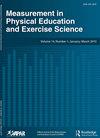体育教学中抓握和垂直跳跃评估的现场评估
IF 1.9
4区 教育学
Q2 EDUCATION & EDUCATIONAL RESEARCH
Measurement in Physical Education and Exercise Science
Pub Date : 2021-12-08
DOI:10.1080/1091367X.2021.2013231
引用次数: 4
摘要
摘要:本研究考察了在体育教学环境中进行计划性干预后,握力和垂直跳跃的现场评估对变化的敏感性。采用自然主义的实验设计,六年级学生(N = 158)随机接受为期8周的肌肉骨骼力量训练或增强力量训练。采用双向重复测量(程序*时间)方差分析(anova)来检验握力和垂直跳跃测试前后的变化。检验垂直跳跃得分变化的双向方差分析结果显示,在增强力量组中,项目与时间的交互效应具有统计学意义(p < 0.001),收益更大。握力的平行分析没有统计学意义,但握力分数的百分比变化在肌肉骨骼力量组更大。结果与特异性原则一致,并表明,如果学生在体育课上接受适当设计的肌肉骨骼编程,基于现场的肌肉骨骼健康评估对变化敏感。本文章由计算机程序翻译,如有差异,请以英文原文为准。
Field Evaluation of Handgrip and Vertical Jump Assessments in Physical Education
ABSTRACT The study examined the sensitivity to change of field assessments of handgrip strength and vertical jump following programmatic interventions in physical education settings. Using a naturalistic experimental design, classes of 6th grade students (N = 158) were randomized to receive either an 8-week musculoskeletal strength or plyometric power program in physical education. Two-way repeated measures (program*time) ANOVAs were used to examine pre-post changes in handgrip and vertical jump tests. Results of the two-way ANOVA examining changes in vertical jump scores revealed a statistically significant program*time interaction effect (p < .001) with larger gains in the plyometric power group. The parallel analysis on handgrip was not statistically significant, but percent changes in handgrip scores were larger in the musculoskeletal strength group. The results are consistent with the specificity principle and demonstrate that field-based musculoskeletal fitness assessments are sensitive to change if students receive appropriately designed musculoskeletal programming in physical education classes.
求助全文
通过发布文献求助,成功后即可免费获取论文全文。
去求助
来源期刊

Measurement in Physical Education and Exercise Science
Medicine-Orthopedics and Sports Medicine
CiteScore
4.20
自引率
33.30%
发文量
24
期刊介绍:
The scope of Measurement in Physical Education and Exercise Science (MPEES) covers original measurement research, special issues, and tutorials within six substantive disciplines of physical education and exercise science. Six of the seven sections of MPEES define the substantive disciplines within the purview of the original research to be published in the journal: Exercise Science, Physical Activity, Physical Education Pedagogy, Psychology, Research Methodology and Statistics, and Sport Management and Administration. The seventh section of MPEES, Tutorial and Teacher’s Toolbox, serves to provide an outlet for review and/or didactic manuscripts to be published in the journal. Special issues provide an avenue for a coherent set of manuscripts (e.g., four to five) to collectively focus in-depth on an important and timely measurement-related issue within the scope of MPEES. The primary aim of MPEES is to publish high-impact manuscripts, most of which will focus on original research, that fit within the scope of the journal.
 求助内容:
求助内容: 应助结果提醒方式:
应助结果提醒方式:


